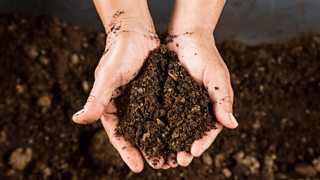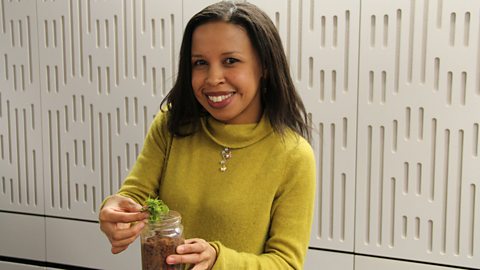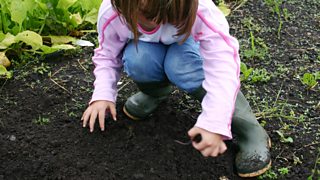Five things you always wanted to know about soil (but were too embarrassed to ask)

In a world where an increasingly small proportion of people work on the land, many of us don’t give soil a second thought. Yet it's a hugely important substance that we humans – and pretty much every other species on the planet – simply couldn’t live without.
But don't worry if you feel that you don't know the first thing about it. As Free Thinking assembles a team of experts to tell Soil Stories Old and New, here’s a quick Q&A to help you get to know the ground beneath your feet.
What even is soil?
If you think of the earth as resembling an onion with a series of layers, the soil is the outermost of those layers. It’s the planet’s skin: scientists call it the pedosphere. Below it is the lithosphere (Earth’s rocky crust) and above it, only air (the atmosphere).
It's said that a single tablespoon of soil contains more lifeforms than there are people on earth
The material itself is a mixture of minerals, organic matter, water and air. The exact ratios of each vary between soil types and locations, but in general about a quarter is water and another quarter air. The remaining half is made up of mineral content (i.e. pulverised rocks) and organic matter (i.e. decaying plants and animals, as well as billions of tiny organisms). The amount of each varies wildly according to the topography of the surrounding area.
If soil is full of rotting plants and animals, why doesn’t it smell?
Some soil does smell bad to humans. But a lot of the time, it can smell inoffensive, even good (think of that delightfully fresh “petrichor” scent you get immediately after rainfall). Part of the reason is can smell fresh-smelling is the large volumes of water that drain through it, removing many harmful organisms and toxins.
The presence of life in the soil also helps prevent it smelling like death. It’s said that a single tablespoon of soil can contain more lifeforms than there are people on earth. That’s millions upon millions of microbes, fungi, bacteria, fungi and bigger creatures (like worms) constantly moving through and processing it.
Can I eat it?
Some people think that soil *tastes* alright too – listen to the Free Thinking panel doing a taste test here. But you don’t need to have eaten soil to know when something tastes “earthy”. To some extent, you can taste soil in the plants that grow in it (and the products we make from them).
But the short answer, unsurprisingly, is no. The odd fleck on your veggies won't do you any harm, but if you’re often faced with the urge to chow down on the stuff in your flowerbeds, you should probably pay a visit to your doctor – or at the very least, take a good look at your diet. Geophagia (the practice of eating earth or earth-like substances) can be a sign that your body is starved of essential minerals. It can also be a symptom of pica, an eating disorder where sufferers feel compelled to eat things that aren’t food.

Soil Stories Old and New
Free Thinking: Matthew Sweet talks soil with Andrew Scott & poet Elizabeth-Jane Burnett.
How do I make stuff grow in the soil I have?
A proper understanding of this subject requires years of detailed study of soil science (and several decades of listening to Gardeners’ Question Time over on Radio 4). But basically speaking, people who want to grow plants should start thinking about the texture of the soil available to them, and how acid or alkaline it is.
Digging a hole in the ground is one of the best ways to spend an afternoon known to man
Most plants like a neutral or slightly acidic soil, while acidic soil is a natural home for plants like heathers, rhododendrons, azaleas, gardenias or holly. Alkaline soils are harder to grow things in, generally speaking, and gardeners spend a lot of time trying to lower their pH level with special fertilisers.
When it comes to texture, you’ll need to identify whether your soil is sandy or clay-based. Clay-based soil holds water well – so is super fertile – but it can also dry rock-hard, making it difficult to plant. Meanwhile, sandy soil is good at draining, but also sucks water away from plants. The best soil for growing things, generally speaking, is an even-textured variety called loam, which has a mixture of different sized particles.
How do people know what kind of soil they have?
Experienced gardeners will look at the plants already growing in an area then work backwards to identify the type of soil they're working with. But newbies should visit the National Soil Resources Institute’s Soilscapes map, which provides detailed information about the natural soil in every part of the UK. You can search by postcode, by soil type or simply browse the map. Be warned, though – it’s surprisingly addictive.
If you’re feeling hands-on, then arm yourself with a trowel and get outdoors. Digging a hole in the ground is not only one of the best ways to spend an afternoon known to man, but will expose layers of colours and consistencies that give clues to the geological history of your area. Scientists use tools like colour charts to tell what kind of soil they’re dealing with – you can look these up online. And the Royal Horticultural Society website has a good guide for testing pH levels.
Bear in mind that if you live in a town or city, the soil in your garden is likely to have been brought in from another location. The best place to look for native soil is local woodland, which unlikely to have been interfered with or disturbed. Happy digging!
Matthew Sweet bring together a poet, environmental scientist, geologist and historians to discuss soil, culture and survival stories in Free Thinking. Listen on the Radio 3 website, via the iPlayer Radio app, or download the Arts and Ideas podcast.
-
![]()
Free Thinking: Soil stories, old and new
Poets, historians and scientists unite to examine the ground beneath our feet.
-
![]()
Eight incredibly offensive Victorian valentines
"Insult cards" were almost as popular as the real thing in mid-19th-century Britain.
-
![]()
Meet Eric, Britain's first robot
The original "moving, talking" man of steel has been resurrected for a new exhibition.
-
![]()
The dark history of the treadmill
How did a Victorian instrument of punishment become our favourite piece of gym equipment?




